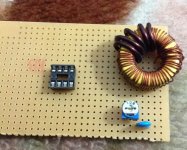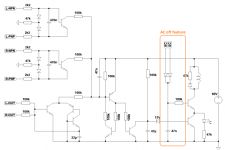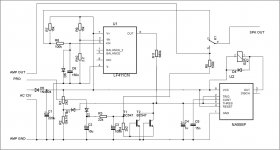It works well. Which protection is it?
Sajti
Hello Sajti
greetings its just a modification from the circuit posted by me with a 4 transistor
delay on and latch better overload protection is ready i used old yellow smps
core for current sensing 4 transistors and ic TLO72 for stereo overload and dc
protection
warm regards
Andrew
greetings its just a modification from the circuit posted by me with a 4 transistor
delay on and latch better overload protection is ready i used old yellow smps
core for current sensing 4 transistors and ic TLO72 for stereo overload and dc
protection
warm regards
Andrew
I built a 2nd version of my protection attached and now it
has a strange behaviour relating to the "AC off" feature:
after AC off the LED lights after a few seconds untill the main caps are discharging completely.
I checked the voltages at the AC points and there is ~3V...
But I dont get it: how there can be a voltage after the mains are off..? 😕
has a strange behaviour relating to the "AC off" feature:
after AC off the LED lights after a few seconds untill the main caps are discharging completely.
I checked the voltages at the AC points and there is ~3V...
But I dont get it: how there can be a voltage after the mains are off..? 😕
Attachments
Wow, I checked with scope now and the trafo scondaries have up to 15V half waves when
the main plug is connected and just one wire (either the neutral or live) is switched... 😱
When I fully unplug it then it's only 1V (even that's surprising to me...) and when I touch the plug, it goes to 2Vp... 🙄
I guess its some capacitive coupling..?!
the main plug is connected and just one wire (either the neutral or live) is switched... 😱
When I fully unplug it then it's only 1V (even that's surprising to me...) and when I touch the plug, it goes to 2Vp... 🙄
I guess its some capacitive coupling..?!
Ok, problem solved: it was really a capacitive coupling...
I grounded the secondary which I use for AC off with a 22k resistor and not it's perfect...!
I grounded the secondary which I use for AC off with a 22k resistor and not it's perfect...!
I have been reading some of the output short circuit protection here. So far, the basic Leach design of current limiting looks good. But I don't know why people are so against use fuse.
I don't think it's a good idea to put the fuse in series with the speaker. I am planning to put two fuses on the power amp pcb for the two rails. Depend on the max current drawn of the amp, say put a 6A fuse on the +V and -V before going to the collectors of the big BJTs in the EF output stage. If you have two or more pairs of output transistors, I cannot imagine the transistor will blow before the fuse.
Hell, find me a big power transistor that has max Ic less than 10A!!! It should be safe to use rail fuse even for one single pair of output transistors. I cannot imagine the transistor blow before the fuse.
Of cause, you adjust the size of the fuse according to the maximum output current of your amp, even 10A fuse should be find for any amp with two or more pairs of output transistors( with reasonable value emitter resistors).
I don't think it's a good idea to put the fuse in series with the speaker. I am planning to put two fuses on the power amp pcb for the two rails. Depend on the max current drawn of the amp, say put a 6A fuse on the +V and -V before going to the collectors of the big BJTs in the EF output stage. If you have two or more pairs of output transistors, I cannot imagine the transistor will blow before the fuse.
Hell, find me a big power transistor that has max Ic less than 10A!!! It should be safe to use rail fuse even for one single pair of output transistors. I cannot imagine the transistor blow before the fuse.
Of cause, you adjust the size of the fuse according to the maximum output current of your amp, even 10A fuse should be find for any amp with two or more pairs of output transistors( with reasonable value emitter resistors).
I cannot imagine the transistor will blow before the fuse.
I can imagine it. Been there, done that and have the T shirt to prove it.
Hello
greetings i want to make a low impedance overload detector if speaker impedance
is below 2 ohms relay should cut off amp is a faster op amp like LM393 better than
a TLO72
warm regards
Andrew
greetings i want to make a low impedance overload detector if speaker impedance
is below 2 ohms relay should cut off amp is a faster op amp like LM393 better than
a TLO72
warm regards
Andrew
I can imagine it. Been there, done that and have the T shirt to prove it.
Yeh, BUT, transistor has a max current. I just cannot imagine a transistor that spec for 15A max current can blow before a 6A fuse. It's all thermal and the fuse should go first. If you have 4 output pairs in parallel, I just cannot imagine it will blow before a 10A fuse.
I don't mean to challenge and dis-respectful to the more experienced. But I really would like to see the schematic of the one that blow to see why the transistor blow before the fuse.
Peak current of MJW3281/1302 is 25A, 2AC5200/2SA1943 is 15A. You just don't blow even with a 10A fuse even with one pair. If you use 10A fuse, you better have at least 2 pairs to be safe. If it blows, you can write and challenge On-semi and Toshiba.
Respectfully.
Last edited:
Hi,
To StephenR : Murphy's law say if you use a fuse to protect a transistor the transistor will protect the fuse. That it is why you do not use a fuse to protect the transistor.
To StephenR : Murphy's law say if you use a fuse to protect a transistor the transistor will protect the fuse. That it is why you do not use a fuse to protect the transistor.
I would like to see the schematic of the one that blow with the protection fuse. It's important to put into context.
I can see there might be problem if the fuse is between the main rectifier and the by reservoir cap. The fuse should be after the reservoir cap. It should be between the big cap and the power transistor. If the fuse is before the reservoir cap, the cap would provide so much current that burn the transistor before the fuse. So schematic is needed to put into context.
I can see there might be problem if the fuse is between the main rectifier and the by reservoir cap. The fuse should be after the reservoir cap. It should be between the big cap and the power transistor. If the fuse is before the reservoir cap, the cap would provide so much current that burn the transistor before the fuse. So schematic is needed to put into context.
Last edited:
The admitted fault current of even 'semiconductor rated' fast fuses exceeds a magnitude of the label current in the vicinity of 1ms. The audiophile status quo usually means that anybody building an amp here has more than enough fault current capability to meet the needed output device destruction conditions, without significantly de-rating the amplifier capability due to small fuses.
Hence fuses are usually reserved for the function of preventing the amplifier from becoming a roaring furnace after the smoke has been released.
Hence fuses are usually reserved for the function of preventing the amplifier from becoming a roaring furnace after the smoke has been released.
Last edited:
Hello
greetings i want to make a low impedance overload detector if speaker impedance
is below 2 ohms relay should cut off amp is a faster op amp like LM393 better than
a TLO72
warm regards
Andrew
It is not very complicated. Crest Audio IGM circuit based on it, so You can apply such kind of solution.
Sajti
Hello
greetings i want to make a low impedance overload detector if speaker impedance
is below 2 ohms relay should cut off amp is a faster op amp like LM393 better than
a TLO72
warm regards
Andrew
Schematic from my thread.
Attachments
The admitted fault current of even 'semiconductor rated' fast fuses exceeds a magnitude of the label current in the vicinity of 1ms. The audiophile status quo usually means that anybody building an amp here has more than enough fault current capability to meet the needed output device destruction conditions, without significantly de-rating the amplifier capability due to small fuses.
Hence fuses are usually reserved for the function of preventing the amplifier from becoming a roaring furnace after the smoke has been released.
Can you explain more, I really don't understand what you are trying to say. Sorry.
- Home
- Amplifiers
- Solid State
- diy short circuit protection



